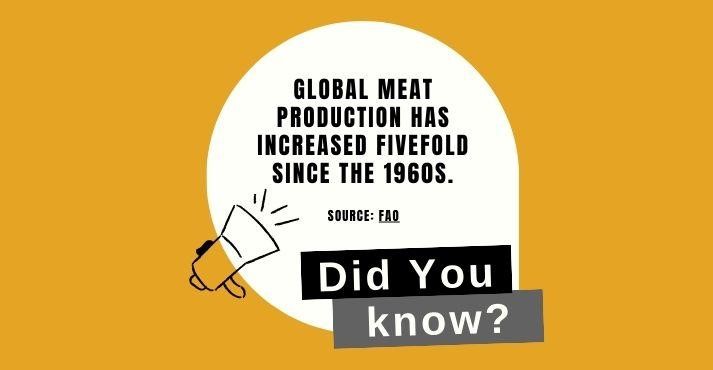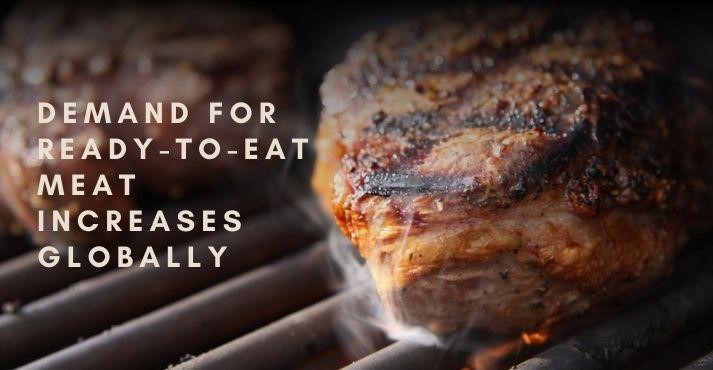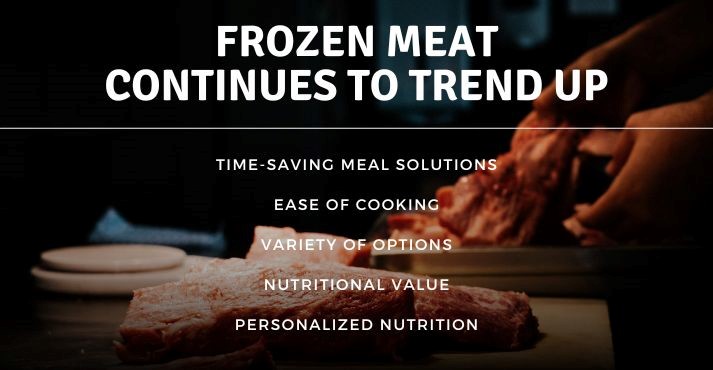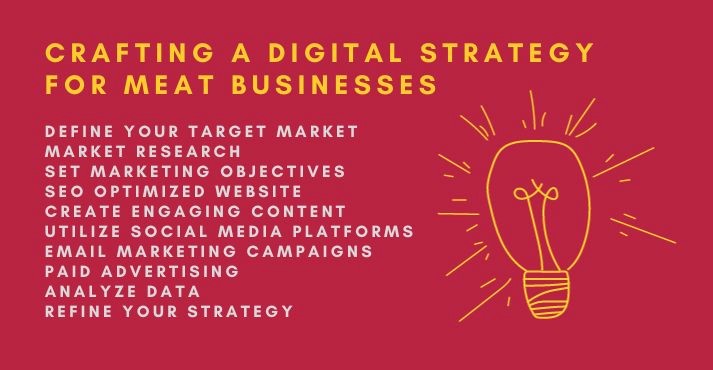Global meat production has increased rapidly over the years.
The revenue from the global meat industry amounts to US$1,472 billion in 2024 and is expected to grow annually by 6.24% (CAGR 2024-2028).
Even with the rising prices, consumers haven’t stopped consuming meat; instead, they have changed the type, cut, and brand of meat to save money.
Today, purchase decisions are driven by value in terms of price, convenience, and other vital attributes. Increasing consumption of packaged food and beverages using processes like salting and smoking for flavor has made significant strides.
New trends in the meat sector, such as flavor fusion, organic shift, digital strategy, automation, and market dynamics, are set to transform meat and dairy production to meet the changing lifestyle and consumer preferences.
Let’s get started with an important question.
What is the future of meat consumption?

Demand for meat is only going up!
The statistics and data from the Food and Agriculture Organization of the United Nations show that global meat production has increased fivefold since the 1960s. Despite many food supply chain disruptions during the pandemic, meat consumption did not lead to a decline.
More people are consuming meat than ever before. Both population growth and demographic changes have led to increased market demand.
However, the meat sector is shifting towards sustainability, ethical practices, and alternative protein production methods to meet future demands.
With increased disposable income and technological innovations in the Asian food and beverage industry, food consumption patterns and market dynamics have shifted.
Top Trends in the Meat Sector
Ready-to-Eat Meats: A Sizzling Trend in the Meat Industry

According to a report by Straits Research, globally, half of the world’s population relies on meat for daily protein needs. Therefore, ready-to-eat meats are becoming a sizzling trend.
With a range of ready-to-eat flavored meat products in the market, volume is expected to amount to 98.8bn by 2028. The ready-to-eat meals market is expected to show a volume growth of 5.0% in 2024.
Factors behind the increase in demand for ready-to-cook food premixes or ready-to-eat meats are:
- Fast-paced lifestyles lead to less cooking time
- Growing acceptance by millennials
- Innovative and flavored ready-to-eat premixes
- Increasing urbanization
- Rising demand for convenience foods
Fast-paced lifestyles and the broader shift in consumer preferences towards convenience foods across generations have fueled the demand for ready-to-eat meat products, making them a staple in today’s fast-paced and convenience-driven food landscape.
Nutrition-Packed Foods: A Growing Priority for Consumers
Half of the consumers call healthy eating a top priority, while the other half consider convenience food. And to satisfy the demand, meat producers need to innovate.
Even before the pandemic, consumers had been experimenting with conscious eating, but COVID-19 accelerated the trend, spurring consumers to look for nutrition-packed foods.
So, what are the growing priorities for consumers today?
- Less time-consuming yet nutritional food
- Transparency in meat production and ingredients
- Sustainable and environmentally friendly products
- Rise of plant-based meat product demand
- Increased demand for healthier and high-quality frozen meat
- Consumption of ethically sourced meat
To ensure consumers consume nutrition-packed foods, food manufacturers must comply with the food safety regulations of the food authorities and provide a nutrition claim, a message that conveys the product’s nutritional properties.
Flavor Infusion: Consumer-Driven Demand for Tastier Meat Selections
A change in consumer demographics has led to an increasing demand for flavourful and tastier meat selections.
While consumers prefer convenience foods over complex meat preparations, they seek varieties such as salami, ham, sausages, bacon, etc. Also, the use of herbs, marinades, seasonings, and spices for taste can be seen in cross-country food cultures.
Meat production now includes methods like glazing and braising, fueling the market growth in meat preservation and demand for product innovation.
The Organic Shift: Consumer Consciousness in Processed Meat
According to a survey conducted by McKinsey, 70% of the respondents across the markets (United States, the United Kingdom, France, and Germany) want to be healthier.
While food is essential for them, 50 percent of respondents across age groups indicated healthy eating is their top priority.
The demand for meat growth sustainability has increased with growing consumer awareness about conventionally reared poultry and cattle.
Consumers are shifting towards healthy, antibiotic-free, and chemical residue-free foods and looking for alternatives to processed meat.
While this organic shift isn’t limited to consumers, meat producers are also adopting organic animal husbandry practices, following best practices for food product authenticity, acquiring certifications, and looking to replace synthetic curing agents (nitrites and nitrates) with celery powder for meat preservation due to health concerns.
Frozen Meat’s Market Lead with Ease of Transportation
Even amid fresh meat’s success, frozen meat alternatives are making inroads with consumers.
Consumers are turning towards frozen meat to bridge the gap between hectic work schedules and the nutritional intake of protein.

5 fantastic reasons frozen meat products will continue to trend up among consumers:
- Time-saving meal solutions
- Ease of cooking
- A variety of options are available
- Nutritional value preservation
- It fits the growing demand for personalized nutrition
While consumers continue to prefer frozen meat, here’s how meat producers are benefiting from them:
- Ease of storage and transportation
- Longer shelf life and lower risk of microbial contamination
- Widely used by food chains for convenience
- Growing consumption of products like salami, sausages, and nuggets, especially in America
- International trade in frozen meat products is on the rise
- Investing in technology and cold chain infrastructure for storage
- Canned meat is cost-effective, affordable, and convenient
Along with this, canned meat has also gained traction among consumers. The global canned meat market was valued at USD 29.84 billion in 2022 and is projected to grow from USD 31.13 billion in 2023 to USD 42.61 billion by 2030, exhibiting a CAGR of 4.59% during the forecast period.
However, the canned meat market grows moderately but is perceived as less nutritious. Meat producers are making ongoing efforts to develop new techniques to overcome quality issues, as chilled meat is stored at low temperatures but is susceptible to discoloration and contamination in the presence of air.
The Poultry Sector Leads with Growing Demand for Packaged Chicken
Across the globe, poultry production is one of the most dynamic and well-organized sectors. The consumption of poultry packaged products has trended up and displaced a substantial amount of red meat consumption.
According to this Research and Markets report, the global chicken market is expected to be US$ 429.11 Billion by 2028.
China produced approximately 15 million metric tons of chicken meat in 2020, the highest in Asia-Pacific. 11 countries in that region produced over one million metric tons in that year. Poultry meat will account for nearly 50% of all meat consumption in Asia by 2031.
Factors driving the growing demand in the poultry sector:
- Population growth continues to rise across the world
- People move into the cities due to urbanization
- Buying power to consumer protein
- There is a high potential for growth in poultry consumption
- Consumers shift towards organic poultry
- Appealing to bodybuilders and health-conscious consumers
- Competitive pricing and nutritional value
- Millennials embrace poultry for daily protein needs
- Use in convenience foods like burgers and sandwiches
All these factors showcase a growing demand for packaged chicken products for the poultry sector producers and manufacturers.
Carcinogenicity and Market Dynamics in Processed Meat
Carcinogenicity and market dynamics are intertwined in the processed meat industry.
A slice of processed meat goes through salting, curing, fermentation, smoking, or other processes to enhance flavor or improve preservation.
The World Health Organization’s (WHO) cancer research arm has determined that linking processed meat consumption to cancer has raised health concerns, impacting consumer choices.
But while red meat has nutritional value, governments and international regulatory agencies are conducting risk assessments and providing the best possible dietary recommendations to balance the risks and benefits of eating red meat.
Consequently, market dynamics have shifted, with growing demand for healthier alternatives and increased scrutiny of processed meat products.
Digital Strategy for Meat Business Growth
Meat producers are increasingly aware of the power of digital strategy.
With immense opportunities for digital transformation, the meat industry has accelerated dramatically since the global pandemic when everything went online.
While automation and ICT technologies have increased the ability to monitor, control, and manage production processes more effectively, a digital strategy has become the driving force to amplify and boost sales and reach.
The idea of digitalization might seem daunting, but accustomed to constant change and the need to adapt, meat producers and manufacturers need to take a step forward.

Essential for future business growth, we’ve listed steps for crafting a digital strategy for meat processors:
- Define your target audience
- Conduct market research
- Set clear marketing objectives
- Develop a website and optimize it for SEO
- Create engaging content (blog posts, videos, etc.)
- Utilize social media platforms
- Implement email marketing campaigns
- Explore paid advertising (Google Ads, Facebook Ads)
- Monitor and analyze data
- Refine your strategy
While doing this, meat producers must know the legal requirements and understand that consumers rely on digital information.
It is important to note that automation isn’t limited to the digitalization of processes; instead, it connects the entire meat business to create an integrated approach and leverage the power of digital platforms to reach potential consumers.
Automation in Process Using Artificial Intelligence
Artificial Intelligence (AI) is poised to be a significant game changer, with no exception in the meat sector. It’s not a matter of “if” but “how much” and “how quickly” AI will be adopted in the industry.
Many industry leaders anticipate AI’s significant impact shortly. Benefits of automating processes using AI in the meat sector:
- Improved meat quality control
- Enhanced supply chain management
- Predictive maintenance for equipment
- Personalized product recommendations
- Efficient demand forecasting
- Reduce labor costs and minimize waste
- Help in ingredient inspection
- Assessing beef ribs involves size, shape, color, and marks
- Data-driven decision and insights
Meat producers are more likely to embrace AI aimed at upgrading food technology for sustainability and production. This may include automated precision farming techniques, real-time health monitoring of livestock, advanced data analytics for optimizing feed and resources, and even the development of lab-grown meat alternative products using AI-driven research and production processes.
These trends are expected to revolutionize the meat industry, ensuring excellent quality, sustainability, and resource efficiency.
Trends in the Meat Sector – FAQS
What are the trends in the meat industry?
Top trends in the meat industry are:
- Plant-based meat alternatives
- Sustainability
- Organic shift
- Traceability and transparency
- Ethical sourcing
- Technology integrations
- Health and wellness trends
- Flavored and specialty meat products
- E-commerce and digitalization
- Convenience and ready-to-eat products
- Globalization and international expansion
What is the current trend in meat consumption?
Current trends in meat consumption are:
- Plant-based and alternative meat consumption
- Increased demand for organic and sustainable meat
- Growing interest in exotic and specialty meats
- Greater focus on health-conscious meat choices
- Expanding global meat trade and consumption
What is the new technology in the meat industry?
New technologies in the meat industry include:
- Artificial intelligence (AI) and machine learning
- Blockchain for supply chain traceability
- Automation and robotics
- High-pressure processing (HPP) technology
- 3D printing for meat production
Conclusion
The trends in the meat sector indicate that worldwide meat production and consumption have drastically increased. Investing in innovation and technology is the only way to stay ahead of the competition and improve efficiency.
In addition, as concerns about the transparency, traceability, and sustainability of meat production increase, meat producers must be ready to embrace practices and technologies that help them reduce waste, minimize energy consumption, and source ethically.
As the meat industry continues to evolve globally, opportunities will increase, and meat producers must be well-prepared to navigate the meat sector’s complex and constantly evolving landscape.





























